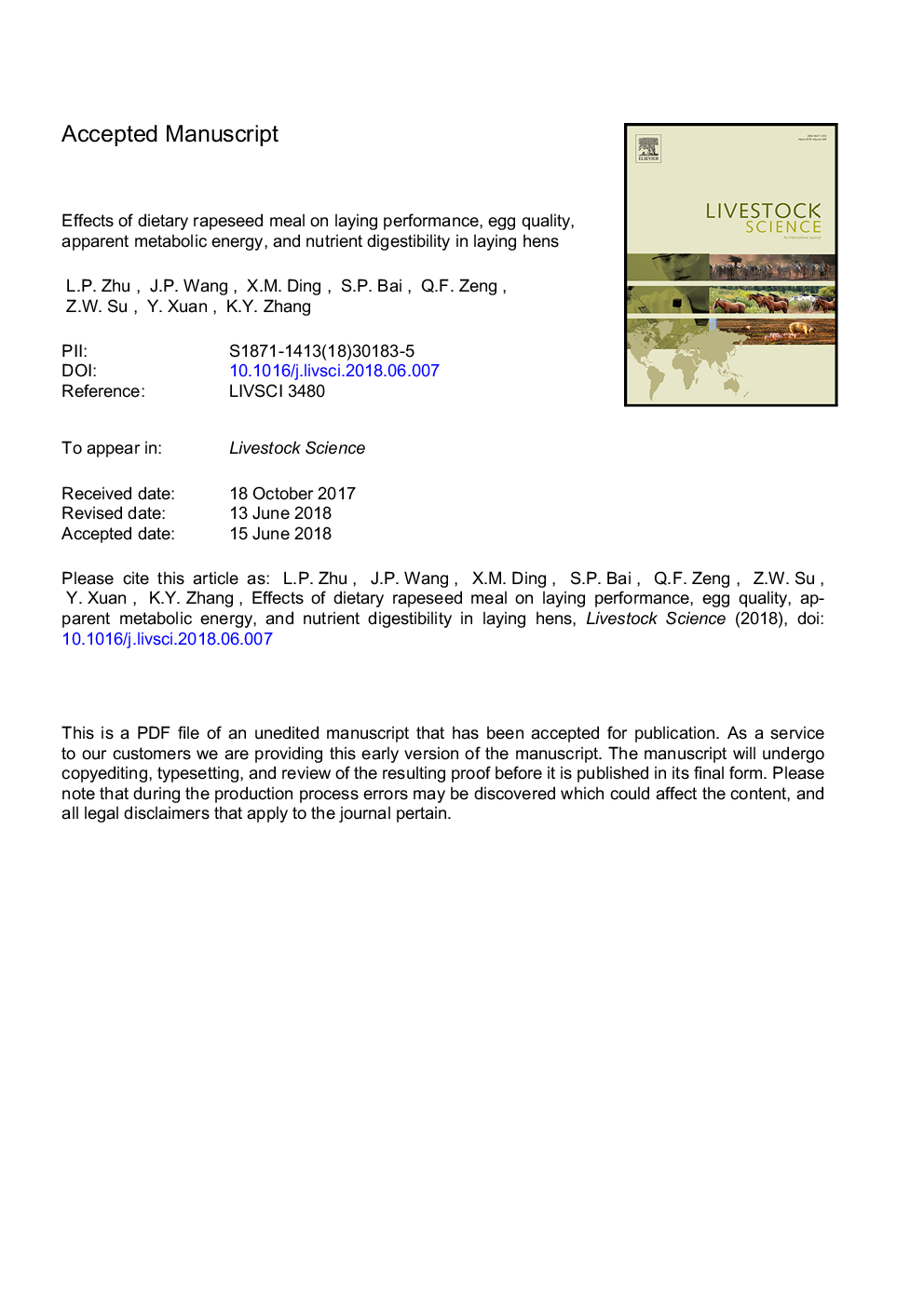| کد مقاله | کد نشریه | سال انتشار | مقاله انگلیسی | نسخه تمام متن |
|---|---|---|---|---|
| 8501898 | 1553918 | 2018 | 28 صفحه PDF | دانلود رایگان |
عنوان انگلیسی مقاله ISI
Effects of dietary rapeseed meal on laying performance, egg quality, apparent metabolic energy, and nutrient digestibility in laying hens
ترجمه فارسی عنوان
تأثیر غذای رژیمی بر عملکرد تخمگذار، کیفیت تخم مرغ، انرژی متابولیکی ظاهری و قابلیت هضم غذا در مرغهای تخمگذار
دانلود مقاله + سفارش ترجمه
دانلود مقاله ISI انگلیسی
رایگان برای ایرانیان
کلمات کلیدی
غذای کلزا، مرغ تخمگذار، عملکرد تولید تخم مرغ، کیفیت تخم مرغ، هضم غذائی
موضوعات مرتبط
علوم زیستی و بیوفناوری
علوم کشاورزی و بیولوژیک
علوم دامی و جانورشناسی
چکیده انگلیسی
The objective of the present study was to investigate the effects of low glucosinolates rapeseed meal (RSM) on laying performance, egg quality, nutrient digestibility, and AME in laying hens. A total of 900 thirty-week-old laying hens were randomly assigned to 6 dietary treatments with 10 replicates per treatment and 5 cages (3 hens) per replicate. The isoenergetic and isonitrogenous diets containing 0, 58.8, 117.6, 176.4, 235.2, and 294.0â¯g RSM/kg were formulated on a digestible amino acid basis. The study lasted for 12 wk. Results showed that the egg production and egg mass linearly decreased with the increased content of RSM (Pâ¯<â¯0.01), and the feed conversion ratio (FCR) increased linearly during wk 1 to 12 (Pâ¯=â¯0.003). The increasing RSM content had a quadratic effect on average egg weight (Pâ¯<â¯0.01) and average daily feed intake (ADFI, Pâ¯<â¯0.01) during wk 1 to 12. The increasing RSM content had a quadratic effect on apparent metabolic energy (AME), N, and amino acid digestibility at wk 12 (Pâ¯<â¯0.04), except Tyr and Ser. Dry matter, Tyr, and Ser digestibility linearly decreased as the RSM concentration increased at wk 12 (Pâ¯<â¯0.01). The egg albumen height decreased linearly at wk 4 and 12 (Pâ¯<â¯0.01 and Pâ¯=â¯0.02, respectively), and Haugh units decreased in a linear manner at wk 4 and 12 (Pâ¯=â¯0.03 and 0.02). The egg yolk color increased linearly with increased content of RSM at wk 4 and 12 (Pâ¯<â¯0.01). The serum triiodothyronine (T3) and thyroxine (T4) linearly increased as the RSM content increasing (Pâ¯<â¯0.01). Using a one-slope broken-line analysis, the breakpoint (BP) for egg weight of daily RSM intake during wk 1 to 12 occurred at 13.6â¯g/hen. The daily RSM intake BP of egg production at wk 1 to 12 occurred at 6.5â¯g/hen. Supplementation of low glucosinolate RSM in hens' diet should be lower than 117.6â¯g/kg in terms of egg production performance, egg quality, blood hormone content, nutrient digestibility, and AME.
ناشر
Database: Elsevier - ScienceDirect (ساینس دایرکت)
Journal: Livestock Science - Volume 214, August 2018, Pages 265-271
Journal: Livestock Science - Volume 214, August 2018, Pages 265-271
نویسندگان
L.P. Zhu, J.P. Wang, X.M. Ding, S.P. Bai, Q.F. Zeng, Z.W. Su, Y. Xuan, K.Y. Zhang,
